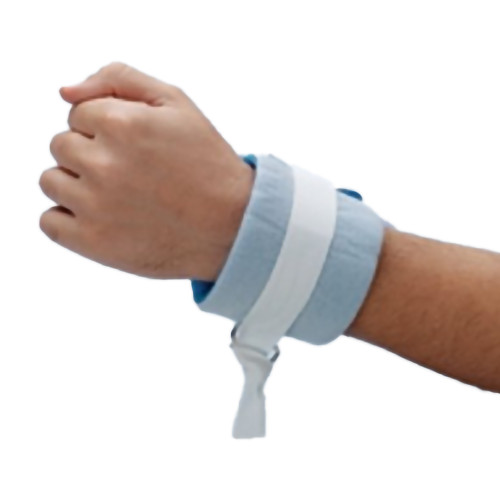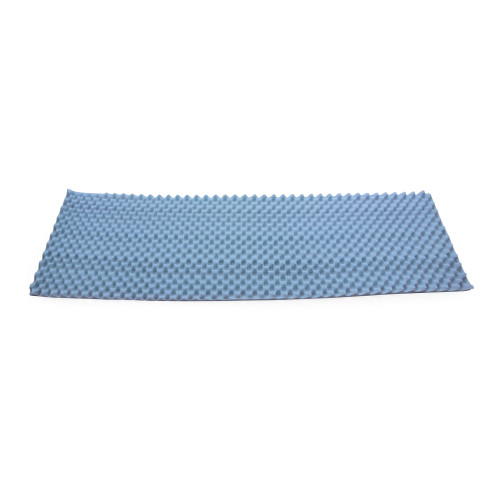-

Posey Grip
Posey Grip Non-Slip Matting Green , 12 X 120 Inch
12 x 120 inches Use with those who slide forward in their chair or bed or need a positioning aid Ideal for healthcare use versus commercially available shelf matting
$19.06 -

Posey
Posey Wrist Ankle Restraint Blue Strap Fastening
The Posey Ankle/Wrist Restraint has an easy-to-apply foam cuff that secures with hook and loop. Restraint secures to movable portion of the bed with a single connecting strap. The D-ring stress point prevents the cuff from tightening when the patient...
$13.27 -

Double-Security Mitts
Double-Security Mitts Hand Control Mitt White Strap Fastening
Posey Double Security Mitts are used to help protect individuals who are prone to disrupting medical treatment or self-harm. This mitt impedes picking and tube pulling and is considered to be a less restrictive device that should be considered and tried...
$42.99 -

Posey
Posey Wrist Ankle Restraint Blue Hook and Loop / Quick-Release Buckle
Slide harness allows the wrist to rotate without chafing and protects delicate skin Quick-release buckle on a two-piece attachment strap, allowing one piece to remain on the bed for fast application Strap length 31-inch Wrist circumference 4 to 12 inch
$16.63 -

McKesson
McKesson Yellow Bag Yellow Bag Biohazard Laundry Bag Twist Tie Closure 100 per Case
Package Count: 100. Made from heavy-gauge materials for high performance and value.Print Label: Infectious Linen Yellow 40 x 46 inch, 1.2 Mil, 40-45 gallon capacity Made from heavy-gauge materials for high performance and value Offers better tear...
$56.65 -

Drive
drive Mattress Cover Fluid-Proof / Contoured White, For Twin Sized Mattresses
Designed to keep mattress clean, and protected from dust, incontinency, odors and stains Made of water-proof, nonallergenic vinyl
$10.73 -

McKesson
McKesson Mattress Overlay Pressure Redistribution Type Blue Convoluted Foam 72 L X 20 W X 2 H Inch
Size: 20 x 72 x 2 inch Distributes body weight evenly Reduces pressure and promotes air circulation for enhanced comfort
As low as $22.23 -

Elkay Plastics
Elkay Plastics Amber Pharmacy Bag, Zip Closure, 3 mil, 9 in x 12 in
Amber bags prevent their contents from being degraded or damaged by UV light waves The convenient seal top closure of these bags make them an excellent choice for packaging and transporting medications and other UV light-sensitive products Made of LDPE -...
As low as $24.65 -

McKesson
McKesson Bed Pillow White Reusable, 21 X 27 Inch
McKesson's Reusable Bed Pillows are vinyl-coated so they may be easily wiped clean. They are soft and flexible and designed to be fluid- and stain-resistant for long-lasting durability. With an exta full loft this pillow keeps a higher height when...
As low as $18.34 -

McKesson
McKesson Bed Pillow Moisture-Resistant White Reusable, 21 X 27 Inch
McKesson's Reusable Bed Pillows are vinyl-coated so they may be easily wiped clean. They are soft and flexible and designed to be fluid- and stain-resistant for long-lasting durability. With an exta full loft this pillow keeps a higher height when...
As low as $18.62 -

Drive
drive Bariatric Mattress Cover White, For Standard Sized Mattresses
Designed to keep mattress clean, and protected from dust, incontinency, odors and stains Made of water-proof, nonallergenic vinyl
$14.34 -

McKesson
McKesson Bed Alarm Sensor Pad, Audible/Visual Alerts, 10 in x 30 in
McKesson fall prevention monitors help monitor your loved one's movements by providing audible and visual alerts. Simply plug the sensor pad, mat or seatbelt into the fall alarm and place under at-risk individuals. When they rise to get up, removing...
$47.25
Bedroom Aids

Bedroom Aids
The bedroom can be a hazardous place for people with mobility issues. It also holds dangers for those with dementia and even people confined to the bed. Below are some of the items which can help make the bedroom a safer space.
Bedrails
Rails can protect the sleeper from falling and give them stability and support when getting into and out of bed. They stand on two legs and have a shelf-like projection that slips between the mattress and box spring to give them added stability.
Bedrails intended primarily for support are usually narrow, with a rounded top, while those meant to keep the sleeper from slipping out of bed are longer and rectangular. Look for a rail that is a comfortable height and provides solid support.
Bed Steps
Bed steps consist of a step-stool, or a series of one or two short steps, with an attached handrail. They are drawn up at the bedside and allow the user to comfortably transfer to the bed rather than struggling to climb in.
Look for steps that are the right height to easily step onto and put the user at the right level for transferring to the bed without effort.
Sit-to-Stand Poles
Sit-to-stand poles also called safety poles or security poles, are a type of vertical, free-standing grab bar that can be installed virtually anywhere — including by the bedside. Sit-to-stand poles can be floor-mounted with hardware, wall-mounted, or a combination of the both; some models use tension rather than hardware to hold them in place.
If you think you may want to move the pole at some point, opt for a tension-mounted model. Also, check the weight rating before purchasing to ensure that the pole will support the weight of the individual using it.
Pressure Pads
Pressure ulcers (sometimes called “bedsores”) can be a genuine danger for people confined to bed for long periods. Pressure sores are the breakdown of skin and underlying tissue due to prolonged pressure on the skin. Not only are they painful, but they are also an invitation to infection. Pressure pads help reduce the likelihood of developing pressure ulcers.
There are various types of pressure pads, from sheepskin pads to those filled with water, gel, or even air. Different shapes and sizes are appropriate for beds and wheelchairs. Which pad you should choose depends on your unique needs, so talk to your healthcare provider about which option is right for you.
Bed Sensor Pads
A bed alarm sensor pad may be a good choice for people in danger of falling or for those with dementia. Bed alarms consist of a pressure-sensitive pad that slips under the bed’s fitted sheet and a monitor unit that alerts if the pad no longer senses pressure. Some units may connect wirelessly.
The sensor pad itself comes in different sizes, depending on the user's weight, so make sure the unit you choose is appropriate for the size of the intended user.
These simple accessories can make the bedroom a much safer place.
The bedroom can be a hazardous place for people with mobility issues. It also holds dangers for those with dementia and even people confined to the bed. Below are some of the items which can help make the bedroom a safer space.
Bedrails
Rails can protect the sleeper from falling and give them stability and support when getting into and out of bed. They stand on two legs and have a shelf-like projection that slips between the mattress and box spring to give them added stability.
Bedrails intended primarily for support are usually narrow, with a rounded top, while those meant to keep the sleeper from slipping out of bed are longer and rectangular. Look for a rail that is a comfortable height and provides solid support.
Bed Steps
Bed steps consist of a step-stool, or a series of one or two short steps, with an attached handrail. They are drawn up at the bedside and allow the user to comfortably transfer to the bed rather than struggling to climb in.
Look for steps that are the right height to easily step onto and put the user at the right level for transferring to the bed without effort.
Sit-to-Stand Poles
Sit-to-stand poles also called safety poles or security poles, are a type of vertical, free-standing grab bar that can be installed virtually anywhere — including by the bedside. Sit-to-stand poles can be floor-mounted with hardware, wall-mounted, or a combination of the both; some models use tension rather than hardware to hold them in place.
If you think you may want to move the pole at some point, opt for a tension-mounted model. Also, check the weight rating before purchasing to ensure that the pole will support the weight of the individual using it.
Pressure Pads
Pressure ulcers (sometimes called “bedsores”) can be a genuine danger for people confined to bed for long periods. Pressure sores are the breakdown of skin and underlying tissue due to prolonged pressure on the skin. Not only are they painful, but they are also an invitation to infection. Pressure pads help reduce the likelihood of developing pressure ulcers.
There are various types of pressure pads, from sheepskin pads to those filled with water, gel, or even air. Different shapes and sizes are appropriate for beds and wheelchairs. Which pad you should choose depends on your unique needs, so talk to your healthcare provider about which option is right for you.
Bed Sensor Pads
A bed alarm sensor pad may be a good choice for people in danger of falling or for those with dementia. Bed alarms consist of a pressure-sensitive pad that slips under the bed’s fitted sheet and a monitor unit that alerts if the pad no longer senses pressure. Some units may connect wirelessly.
The sensor pad itself comes in different sizes, depending on the user's weight, so make sure the unit you choose is appropriate for the size of the intended user.
These simple accessories can make the bedroom a much safer place.
